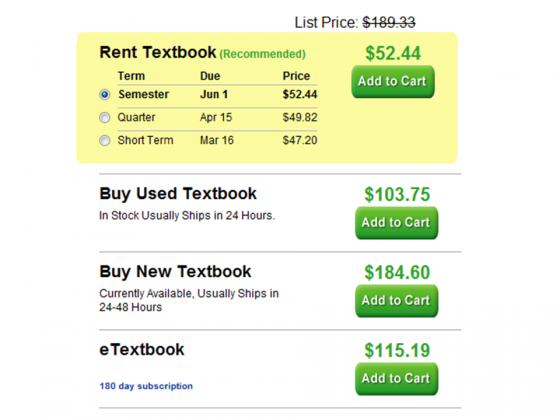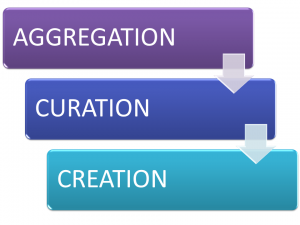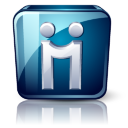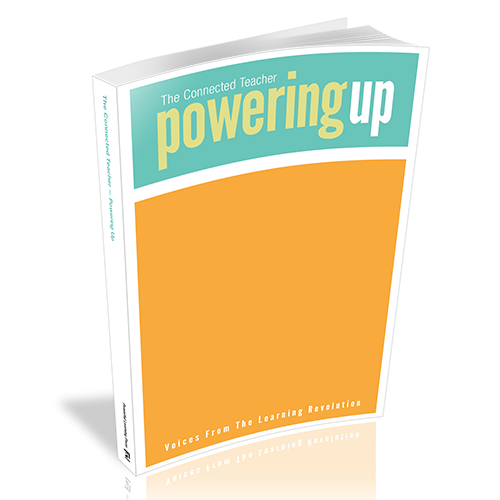
One of the latest buzz words in social media is curation. Some media analysts ponder whether the content curator might be the next big social media job of the future.
In a review of Steven Rosenbaum’s Curation Nation, Frank Paynter wrote that:
The job of curator has spread across the digital media world and may already have replaced “editor” and “publisher” in the minds of marketers and social media mavens.
SO:
- What are the implications of curation in education?
- How will content curation impact the textbook market?
- Will it make textbooks irrelevant?
We are seeing more and more publishers jumping into the digital textbook market but so far the digital editions are mere pdf versions of the hardcover versions. Moreover, these e-textbooks are still very expensive. Let’s take a look at these options for a popular high school Chemistry textbook:

What? The e-textbook version costs $115 bucks and it’s mine for only 180 days. Are you kidding me? High cost is just one of the reasons shown in this infographic: How far students will go to get rid of textbooks–and why.
The Journal’s article: 5K-12 Ed Tech Trends for 2012 includes going ‘Beyond the Digital Textbook’ as one of the trends, with the premise of adding interactivity to digital versions of textbooks. Apple has now partnered with the major textbook publishers with the newly unveiled iBooks Textbooks. There are a handful of textbooks available through iTunes at about $15. These books are constrained to be viewed using iBooks 2 in an iPad with Apple iOS 5. Moreover, it looks like Apple’s new products do not allow social interactivity and collaboration.
Several concerns about Apple’s new enterprise have been voiced in the blogosphere. I recommend reading Audrey Watters’ posting: Apple and the Digital Textbook Counter-Revolution.
Is there an option for a free, relevant course companion? Yes!
With information being ubiquitous, I believe that teachers can (and should) take control of their courses by creating their own interactive textbooks. It might seem like a daunting task, but the availability of quality materials online and the power of tapping into personal learning networks should make this a worthwhile learning journey.
In this post I will explain the process of creating a digital textbook, tools for each step of the process and strategies for involving the students in its development.
Creating Your Own Digital Textbook
THE PROCESS
The process of creating your digital textbook involves three steps:

AGGREGATION
The first step is to gather the sources of information. The best way to aggregate content is through social bookmarking. My favorite tools are Delicious and Diigo.

I would recommend Diigo as ‘its features allow teachers to highlight critical features within text and images and write comments directly on the web pages, to collect and organize series of web pages and web sites into coherent and thematic sets, and to facilitate online conversations within the context of the materials themselves. Diigo also allows teachers to collaborate and share resources among themselves.’
Here is a short video explaining the main features of this tool:
Diigo V5: Collect and Highlight, Then Remember! from diigobuzz on Vimeo.
Strategies
 Collaborate, collaborate, collaborate!
Collaborate, collaborate, collaborate!
Teachers can work with colleagues within their subject area departments and beyond the walls of the classroom to aggregate resources through social bookmarking.
The main sources of information for my professional learning come through my Twitter Personal Learning Network (PLN) and the RSS feeds from Google Reader. If information becomes overwhelming, use an Aggregator such as Paper.li or The Twitted Times. These tools will sift through your connections’ resources and gather the most significant ones.
CURATION
While aggregation can be seen just as collecting websites, the process of curation involves a deeper analysis of the aggregated sites to select the ones that have the most relevant information for a particular topic, just like a museum curator summarizes and edits intricate subjects into easily consumable and enjoyable exhibits.
Strategies
Use your subject area syllabus, state standards or learning objectives to hand pick the content for a particular unit of study. Focus on the essential questions to guide your selection of resources. In order to make your textbook interactive try to include images, videos and simulations to engage your students.
Tools
My favorite free tools for curation are LiveBinders and Scoop.it!
![]() One of the most user-friendly tools to post resources for your course is LiveBinders.
One of the most user-friendly tools to post resources for your course is LiveBinders.
Take a look at this example: Se̱ora Evans РCourse Materials and Resources
Another powerful tool for curation is Scoop-it!.
 This free tool allows you to create your own online magazine.
This free tool allows you to create your own online magazine.
Take a look at my Scoop.it! PhysicsLearn, “Connections to learning resources for physics teachers and students'”.
CREATION
This is the most important (and fun) part of the process as you will design and share how the curated resources will be used in your class.
Tools
Creating an online repository using a wiki digital tool such as Google Sites, PBworks and Wikispaces will enable you to organize your resources neatly. You could also use LiveBinders as you can select a template that allows you to include text for each of your resources. If you have an Apple platform you can use iBooks Author. The free app offers a drag-and-drop template that can be customized with images, interactive diagrams and videos to create a stunning looking book. Learning management systems (LMS) such as Moodle, Edmodo and Schoology are also great alternatives with other neat features for educational social networking.
My favorite is Google Sites. You can easily post images, directly embed videos from YouTube, lecture podcasts, and Google Documents. You can also embed assessments using Google Forms and a calendar. Setting up the site as a wiki by adding the students as collaborators will enable authentic interactivity among teachers and learners
Strategies
Here are some guiding questions for creating your digital textbook:
- How are the learners going to use the information?
- How will they demonstrate their learning?
- Are they completing a document, creating an outline or answering a set of questions?
- What are the assessments associated with the material?
Teacher and Learner Roles
The table below compares and contrasts the elements of the various levels of involvement of teachers and learners in the process of creating a textbook. You can use the traditional model where all steps of the process are managed by the teacher or move towards a learner-centered approach using the chart to determine which level is appropriate for your course:

Here are some examples:
Teacher as curator:
My unit on Projectile Motion includes content information, exercises, a virtual lab and a couple of assessments.
The wiki of my colleague Craig Savage with his resources for AP Biology and AP Psychology.
Students as curators:
American Democracy in Action, a digital textbook for AP US Government created by seniors at St. Gregory College Preparatory School.
For excellent strategies to involve your students take a look at Silvia Tolisano’s posting: Students Becoming Curators of Information.
Resources to Get You Started
Here are some resources for all academic subjects:
iTunesU (iTunes University): This free app enables video, audio, and an integrated Learning Management System with available push notifications options.
CK-12 Foundation: You can customize your own FlexBooks with open-content in all subject areas.
Open Culture Links of 400 Free Online Courses from Top Universities
National Repository of Online Courses: Algebra, Calculus, History, Biology, Environmental Science, Physics and World Religions.
So, are you ready to ditch your textbooks?
Dolores Gende
Latest posts by Dolores Gende (see all)
- My Teaching Evolution: Assessment - December 11, 2012
- Aggregate, Curate and Create Your Own Textbook - January 24, 2012
- How I'll Engage My Students as Learners: Six Ways to Make Connections - September 6, 2011


Just because you can teach 8th grade(or even Grade 12), does NOT mean you can write a decent textbook, even if it does have cute cartoons in it. Oh, it may have some amateur Youtube content, and may be FUN, but the kids will come out just as dumb, un-interested, and ignorant as they went in! Why? Nothing in, nothing out.
Oh, yes, some few teachers may put out some good material, and a few will even collaborate to do so. The rest will put out pap. I have seen it done by several teachers who thought they could write textbooks, and spent more time on that… than on teaching. They used the students they were being paid to teach as guinea pigs for their textbook writing games. All in all, every case was a train wreck.
“All in all, every case was a train wreck.” Which cases are you referring to? The teachers I know who have undergone the intensive textbook creation process created on their own time. Yes, it was applied during the school year, but not in place of teaching. You make it sound like such a negative to use students as guinea pigs, but that means a very personalized and focused study of the student interaction with the textbook. How many published textbooks would actually change the layout or the content to address a need vocalized by the student? I don’t know where your negativity comes from, but teachers who are willing to spend hundreds of hours gathering, curating, and publishing the content are not playing “writing games.” The majority probably deserve respect instead of ridicule. Your attack would suggest otherwise, but it was unsubstantiated and vague.
Pierre’s argument reminds me of the debate about SOPA, PIPA and the media industry’s efforts to control content on the internet. As Clay Shirky describes in a brilliant TED video explaining why SOPA is a bad idea, one of the implied messages is that content creation should be left to “professionals” – which typically means the big media companies (including publishers). Teachers, schools and districts creating their own digital textbooks? Much the same threat, from those companies’ point of view. Watch Shirky’s explanation and you’ll see what I mean: http://bit.ly/Axpfl9
There are plenty of critics of the DIY textbook movement who are stuck in the 20th century model of information delivery. Like it or not, as Seth Godin says, information is now free or very close to it. We need to shift our focus to helping students to discriminate among that content – to grow those skills at the top of the new Bloom’s: analyzing, evaluating, and creating.
Dear Dolores,
I thought you did a terrific job of laying out the How To’s in this article as it touched on things that I’ve never been quite sure how to go about doing.
Imagine my surprise to read Pierre’s comment which seemed so harsh. Yet he does bring up a good point. How will we make sure that the information we bring to students is high quality? Is this a new task for teachers?
For as long as I can remember, teachers have been developing resources to use in a course. They bring in articles, movies, experiences and a textbook. I’d imagine that a teacher’s first effort at this will not be to necessarily replace a textbook, but to add to it.
I know I don’t use a textbook as the one and only source of expertise. In a science classroom, we use the textbook more as a reference book than the centerpiece of the curriculum. In fact, it is our curriculum that is the centerpiece of what we study and we utilize all sorts of resource, the official published print version of a textbook, as one source.
I am very excited about the possibility of gathering all the other supporting resources into one place that is easily accessible for my students. I thank you for writing such an understandable description of what I might do to get that resource going for my students.
Delores,
Thank you for this. Though its only January, I am looking ahead to my US History course this summer. It will be a blended Online course. Already unhappy with the textbook the department chose three years ago, I use so many other resources on the web that your blog has helped shape how I think about organizing all of this material and give it more shape than currently provided by Moodle. No textbook has every been perfect, supplementing used to be the focus, now we spend more time on primary sources and commentaries beyond the text, that the text is merely a basic reference point for us. What you are describing is the next step –what was supplemental now becomes central. And why not, with Abraham Lincolns speeches out there for students to read, why read short excerpts. With easily accessible commentary by diverse historians such as Zinn, Johnson, and Foner available why settle for an omniscient textbook presentation of “the facts”.
I agree students need grounding, they need fundamentals, but they also need to be challenged with the complex ideas that confronted those who came before us and continue to face us today.
I found your comments on aggregating and curating particularly helpful. I see this as a way to focus my preparation for my new course.
Exceptional post for creating digital learning environments. I like how you have put the process together giving a nice touch to Curation Nation concepts and blending them into the creation of digital media. The post has given me some great ideas on facilitated learning in the co-creative elaborative learning environment. I would like permission to reference your thoughts in one of my upcoming presentations. I do believe that there will be a need for digital referencing or link back to sources that we will need to teach especially when curated content is shared. Curation is essential in a mobile learning environment when internet resources become unavailable, it provides a way to equalize the playing field. http://digitalsandbox2.blogspot.com/2011/10/dotepub-and-equitable-mobile-learning.html
Thanks again for knowledge sharing, Mike @ The Digital Sandbox. http://digitalsandbox.weebly.com/
NASSP Digital Principal Award 2012
I think the post did a great job explaining all the steps necessary for creating your own textbook. I agree with Marsha, most teachers have been gathering digital content to supplement a traditional textbook for years. The challenge them becomes how to share all the interesting and engaging resources with students.
As schools move to 1:1 or BYOT having a digital textbook becomes the obvious answer. I had done research on many of the same sites you linked to, but none of them covered the curriculum that I needed, so I created my own over the past 2 years. I followed the same aggregate, curate, and creation steps that you listed, occasionally an additional creation of media/content step when I couldn’t find something to fit the need. Another awesome website for the creation process is Weebly. Weebly automatically creates a mobile version of the website, which is perfect for students who view using an iPhone, iPod Touch, or other smaller device.
Students, parents, and other teachers have had positive feedback. I continue to update it on an almost weekly basis, so the students know it is personalized to fit their educational interests and learning needs. I would not claim that it was an easy process, but it was worthwhile in the end. I will be sharing your article with people who ask how to go about writing their own textbook.
It is not so much about teachers creating content in one of many available digital formats it os more about teaching students to create their own digital text. Take for example Andrea Santilli, a teacher at Woodlawn Beach Middle School in Gulf Breeze Florida, is taking a new approach in helping her students to be organizers and creators of content. Her seventh grade science class has just recently published a digital book using iAuthor. The digital iBook has taken the number one spot for nature downloads. The ibook published on iTunes is entitled, “Creatures, Plants and More! A Kid’s Guide to Northwest Florida.”
Andrea Santilli’s science classroom is a point of reference that breaks away from traditional learning options. Her classroom has become connected through the creation of digital content. Santilli’s classroom is an example of how a team of students were asked to learn on their own as they applied new knowledge to expand a deeper understanding of selected content. Her classroom became a connected classroom where students were at the center of knowledge obtainment and shared their work with others. They were strategically linked to the process of engaged activities as they were asked to perform authentic tasks. These facilitated instructional strategies used by Andrea Santilli, were masterfully exercised to elaborate the learning process without influencing student choices. The students were also given support throughout the project to guide them in finding the exactness of knowledge and skill obtainment.